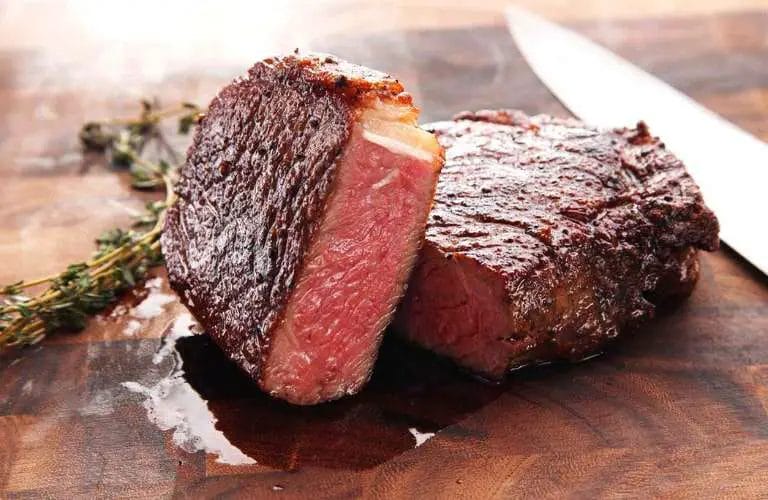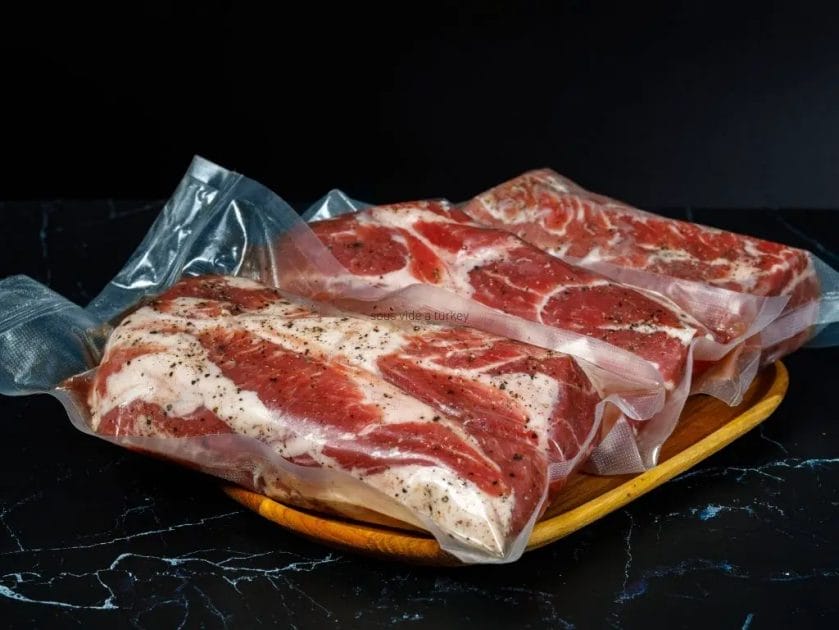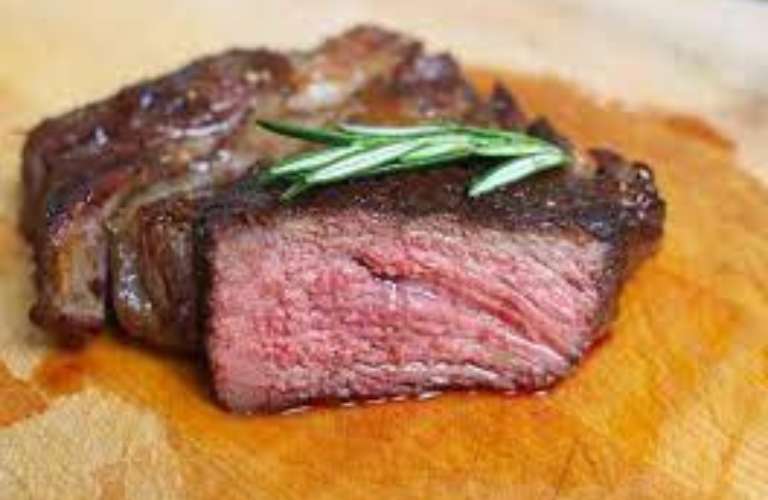If you’re wondering whether you can freeze sous vide steak, the answer is a resounding yes! Sous vide cooking has gained popularity for its ability to produce perfectly cooked steaks with amazing tenderness and flavor.
And the best part is, you can easily freeze your cooked sous vide steak without sacrificing its quality. Freezing sous vide steak allows you to have a delicious meal on hand whenever you’re ready to enjoy it.
In this article, we’ll explore the benefits of freezing sous vide steak and share some tips on how to do it effectively.

The Benefits of Freezing Sous Vide Steak
Sous vide cooking has become increasingly popular among food enthusiasts, and for good reason. This unique cooking method involves sealing food in a vacuum-sealed bag and cooking it in a water bath at a precisely controlled temperature.
One of the key advantages of sous vide cooking is the ability to freeze the food, particularly steak, without compromising its taste or texture. In this section, we will explore the benefits of freezing sous vide steak.
1. Improved Flavor
When you freeze steak using traditional methods, the freezing process can damage the cell structure of the meat, resulting in a loss of moisture and flavor.
However, when you freeze steak using the sous vide method, the vacuum-sealed bag prevents any moisture loss during freezing. As a result, the steak retains its natural juices and flavors, leading to a more flavorful eating experience.
2. Enhanced Texture
Freezing steak using traditional methods can often lead to freezer burn, which can negatively impact the texture of the meat. Freezer burn occurs when the moisture on the surface of the steak evaporates, causing it to become dry and tough.
With sous vide freezing, the vacuum-sealed bag creates a protective barrier that prevents freezer burn, preserving the tenderness and juiciness of the steak.
3. Convenience and Meal Planning
Freezing sous vide steak allows for convenient meal planning and preparation. By freezing individual portions of steak, you can easily thaw and cook them whenever you desire.
This is particularly useful for busy individuals or families who want to enjoy a delicious steak dinner without the hassle of extensive preparation. Simply thaw the frozen steak, season it to your liking, and place it in the sous vide water bath for a perfectly cooked steak.
4. Extended Shelf Life
With traditional freezing methods, the shelf life of steak is typically limited to a few months before the quality starts to decline.
However, when you freeze steak using the sous vide method, the vacuum-sealed bag provides an airtight seal that prevents freezer burn and extends the shelf life of the steak. This means you can enjoy high-quality steak for an extended period, without worrying about it spoiling.
5. Consistent Results
Sous vide cooking is known for producing consistent and precise results every time. Freezing sous vide steak ensures that each piece of steak is frozen at the same temperature, allowing for even and consistent thawing.
This promotes uniform cooking and eliminates the risk of overcooking or undercooking the steak. With sous vide freezing, you can expect perfectly cooked steak with a desired level of doneness.
How to Properly Freeze Sous Vide Steak
Freezing sous vide steak is a great way to preserve the quality and taste of your meat for future use. By properly freezing your steak, you can ensure that it retains its juiciness and tenderness even after thawing. Here are some steps to help you freeze sous vide steak correctly:
1. Choose the Right Cut
When selecting a steak to freeze, it’s essential to choose a cut that will hold up well during the freezing and thawing process. Opt for thicker cuts like ribeye, sirloin, or filet mignon, as they tend to retain their texture and flavor better.
2. Vacuum Seal
Vacuum sealing is the best method for freezing sous vide steak as it prevents freezer burn and helps maintain the meat’s quality. Place the steak in a vacuum-sealed bag and remove as much air as possible before sealing.
3. Label and Date
It’s crucial to label and date your sous vide steak before freezing. This way, you can keep track of how long it has been in the freezer and ensure you use it within the recommended time frame.
4. Flash Freeze
To speed up the freezing process and preserve the steak’s texture, you can opt for flash freezing. Place the vacuum-sealed steak in the coldest part of your freezer or use a blast chiller if available. This process prevents the formation of large ice crystals, which can affect the meat’s quality.
5. Store Properly
Once the steak is frozen, make sure to store it in an airtight container or a freezer bag to prevent any potential exposure to air and moisture. This step further helps to preserve the steak’s flavor and texture.
6. Thaw Before Sous Vide Cooking
When you’re ready to cook your sous vide steak, it’s essential to thaw it properly before cooking. The recommended method is to transfer the frozen steak to the refrigerator and let it thaw slowly overnight. Once fully thawed, you can proceed with the sous vide cooking process.
7. Follow Sous Vide Cooking Times and Temperatures
When cooking your thawed sous vide steak, it’s crucial to follow the recommended cooking times and temperatures for the specific cut you’re using.
This information can be found in sous vide cooking guides or recipes. Cooking sous vide ensures precise and consistent results, producing a perfectly cooked steak every time.
8. Sear After Cooking
After sous vide cooking your steak, it’s essential to give it a final sear to create a delicious crust and enhance the overall flavor. Heat a skillet or grill to high heat and sear the steak for a minute or two on each side until it develops a beautiful brown crust.
9. Enjoy!
Once your sous vide steak is seared, it is ready to be served and enjoyed. The proper freezing and cooking techniques ensure that your steak remains tender, juicy, and full of flavor, providing a delightful dining experience.

Tips for Maintaining Quality When Freezing Sous Vide Steak
Freezing sous vide steak is a convenient way to preserve the freshness and tenderness of the meat for later use. However, improper freezing techniques can negatively impact the quality of the steak. In this section, we will discuss some helpful tips to maintain the quality of sous vide steak when freezing.
1. Pat Dry Before Freezing
Before freezing your sous vide steak, it is important to ensure that it is completely dry. Excess moisture can lead to ice crystals forming on the surface of the meat, which can affect its texture and flavor. Pat the steak dry with paper towels to remove any moisture before placing it in the freezer.
2. Vacuum Seal for Best Results
Using a vacuum sealer is highly recommended when freezing sous vide steak. Vacuum sealing removes air from the packaging, reducing the risk of freezer burn and preserving the steak’s quality. Make sure to follow the manufacturer’s instructions for proper vacuum sealing.
3. Use Freezer-Safe Packaging
When freezing sous vide steak, it is important to use packaging that is specifically designed for freezer storage. Freezer-safe bags or containers help protect the meat from freezer burn and maintain its moisture content.
Ensure that the packaging is airtight to prevent any air from entering or moisture from escaping.
4. Label and Date the Packaging
To maintain organization and keep track of the freezing time, it is essential to label and date the packaging. This will help you identify the steak easily and ensure that it is consumed within the recommended timeframe.
Use a permanent marker to write the date and any additional details on the packaging.
5. Freeze at the Right Temperature
Set your freezer to a temperature of 0°F (-18°C) or below for optimal preservation of the sous vide steak. This low temperature prevents bacterial growth and maintains the quality of the meat. Avoid storing the steak in the freezer door, as the temperature fluctuates more frequently in that area.
6. Thaw Properly Before Cooking
When you are ready to cook your frozen sous vide steak, it is important to thaw it properly. The best and safest method is to thaw the steak in the refrigerator overnight. This slow thawing process ensures even defrosting and preserves the steak’s texture and flavor.
7. Cook Immediately After Thawing
Once your sous vide steak has thawed, it is recommended to cook it immediately. Avoid refreezing the steak, as it can compromise the quality and safety of the meat. Plan your cooking schedule accordingly to avoid unnecessary delays after thawing.
8. Monitor Quality After Thawing
After thawing the sous vide steak, inspect its quality before cooking. Look for any signs of freezer burn, such as discoloration or dry patches. If the steak appears to have significant freezer burn, it is best to discard it to ensure the best dining experience.
9. Adjust Cooking Time and Temperature
When cooking previously frozen sous vide steak, it may require slightly longer cooking times and temperature adjustments compared to fresh steak. Follow the recommended cooking guidelines for frozen meat provided by your sous vide machine or recipe to ensure the steak is cooked to perfection.
10. Enjoy the Sous Vide Steak
Finally, after following these tips and properly freezing, thawing, and cooking your sous vide steak, it’s time to enjoy the delicious results. Serve the steak with your favorite sides and savor the tenderness and flavor that sous vide cooking brings to your culinary creations.
By following these tips, you can ensure the quality and taste of your sous vide steak remain intact when freezing. Proper storage and handling techniques will help you enjoy restaurant-quality meals from the comfort of your home, even when using frozen steak.
Thawing and Reheating Sous Vide Steak
Thawing and reheating sous vide steak requires some careful consideration to ensure that the meat remains tender, juicy, and flavorful.
Sous vide cooking is a technique that involves vacuum-sealing food and then cooking it at a precise temperature in a water bath. This method is known for its ability to produce perfectly cooked steaks with consistent results.
Thawing Sous Vide Steak:
Before reheating sous vide steak, it is important to thaw it properly to maintain its quality. Here are a few methods you can use:
- Refrigerator Thawing: Place the vacuum-sealed steak in the refrigerator and allow it to thaw slowly overnight. This method is the safest and most recommended, as it minimizes the risk of bacterial growth.
- Cold Water Thawing: If you need to thaw the steak more quickly, you can use the cold water thawing method. Place the vacuum-sealed steak in a leak-proof bag and submerge it in cold water. Change the water every 30 minutes to ensure that it stays cold. This method can take 1-3 hours depending on the thickness of the steak.
Reheating Sous Vide Steak:
Once the sous vide steak is thawed, you can proceed to reheat it using the sous vide method. Follow these steps:
- Set the water bath temperature: Preheat your sous vide water bath to the desired temperature based on the level of doneness you prefer. For example, if you want a medium-rare steak, set the temperature to 130°F (54°C).
- Vacuum-seal the steak: Place the thawed steak in a vacuum-sealed bag and remove as much air as possible before sealing it. This step is crucial to maintain the tenderness and flavor of the meat.
- Reheat the steak: Submerge the vacuum-sealed steak in the preheated water bath and let it reheat for about 30 minutes to 1 hour, depending on the thickness of the steak. This time allows the steak to reach the desired internal temperature evenly.
- Finish with a sear: After reheating in the water bath, remove the steak from the bag and pat it dry with a paper towel. Heat a skillet or grill pan over high heat and sear the steak for a few minutes on each side to develop a nice crust.
By following these steps, you can successfully thaw and reheat sous vide steak while preserving its texture and flavor. Whether you are preparing a leftover steak or simply want to enjoy a perfectly cooked piece of meat, the sous vide method ensures consistent results every time.

The Best Cuts of Steak for Freezing Sous Vide
When it comes to cooking steak, the sous vide method has gained immense popularity among home cooks and professional chefs alike.
Sous vide involves vacuum-sealing the steak and cooking it in a water bath at a precise temperature for a longer period of time. This slow and controlled cooking process results in a perfectly tender and juicy steak.
One of the advantages of sous vide cooking is that you can easily freeze the steak and cook it at a later time. However, not all cuts of steak are suitable for freezing and cooking sous vide. In this section, we will explore the best cuts of steak that can be frozen and cooked using the sous vide method.
1. Ribeye
The ribeye steak is a popular choice among steak lovers for its rich marbling and intense flavor. It is also an excellent cut for freezing and cooking sous vide.
The marbling of fat helps keep the steak moist and juicy during the cooking process, making it an ideal choice for sous vide cooking. Whether you prefer bone-in or boneless ribeye, both options freeze well and deliver exceptional results when cooked sous vide.
2. Striploin
Striploin, also known as New York strip or sirloin steak, is another great option for freezing and cooking sous vide. This cut is prized for its tenderness and bold beefy flavor.
The striploin steak freezes well and retains its texture and flavor when cooked sous vide. It is a versatile cut that can be cooked to different levels of doneness, making it a favorite among steak enthusiasts.
3. Filet Mignon
Filet mignon, often referred to as the king of steaks, is renowned for its unmatched tenderness. This cut comes from the tenderloin and is known for its melt-in-your-mouth texture.
While filet mignon is already tender, cooking it sous vide takes it to a whole new level. Freezing filet mignon and cooking it sous vide ensures that you get a perfectly cooked steak every time, with no risk of overcooking.
4. Sirloin
Sirloin steak is a popular choice for its balance of flavor and affordability. It is a versatile cut that lends itself well to various cooking methods, including sous vide.
Sirloin steak freezes well and maintains its taste and tenderness when cooked sous vide. Whether you choose top sirloin or bottom sirloin, both options make for delicious and satisfying sous vide steaks.
5. T-Bone
For those who enjoy the best of both worlds, the T-bone steak is the perfect choice. This cut combines the tender filet mignon and the flavorful striploin, separated by a T-shaped bone.
The T-bone steak freezes well and cooks beautifully using the sous vide method. It offers the tenderness of filet mignon and the rich flavor of striploin, resulting in a steak that is truly a gourmet delight.

FAQs
Can you freeze sous vide steak?
Yes, you can freeze sous vide steak. After cooking the steak using the sous vide technique, allow it to cool down to room temperature. Pat it dry and place it in an airtight bag or container.
Label it with the date and freeze for up to 3 months. When ready to eat, simply thaw and reheat the steak using the same sous vide method.
What is sous vide cooking?
Sous vide cooking is a method of cooking food in a temperature-controlled water bath. It involves placing food in a vacuum-sealed bag and submerging it in the water bath for an extended period.
The precise temperature and cooking time help achieve consistent and precise results, resulting in tender and flavorful dishes.
Can I reuse sous vide bags?
It is generally not recommended to reuse sous vide bags. Although some bags may be reusable, they can become damaged or contaminated during the cooking process.
It is safer to use new, high-quality vacuum-sealed bags for each sous vide cooking session to ensure food safety and prevent any potential cross-contamination.
Conclusion
In conclusion, while sous vide cooking is typically not recommended for freezing steak, it is possible with some careful considerations. The sous vide method is known for its ability to perfectly cook steak to the desired level of doneness.
However, when it comes to freezing, it is important to note that the texture and taste of the steak may be altered. Freezing can cause ice crystals to form, potentially affecting the overall quality of the meat. Furthermore, the longer the steak is frozen, the higher the risk of freezer burn and loss of flavor.
If you do choose to freeze sous vide steak, it is recommended to use high-quality vacuum-sealing bags, label the bags with the date of freezing, and consume them within a reasonable time frame to ensure the best results.
While freezing sous vide steak can be done, it is generally recommended to enjoy the steak fresh for the best taste and texture. If you want to preserve the flavor and tenderness of your steak, it is advisable to cook it sous vide and consume it immediately.
However, if you do have leftover sous vide steak and want to freeze it, take the necessary precautions to minimize any potential quality loss. Remember to thaw the frozen steak properly before cooking or reheating to ensure a safe and enjoyable dining experience.
With proper handling and storage techniques, you can still enjoy a delicious sous vide steak even after freezing.

